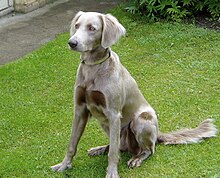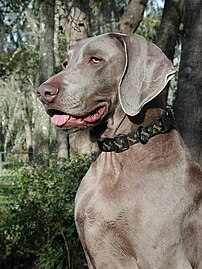Contents
The Weimaraner[a] is a German breed of hunting dog of medium to large size, with history going back at least to the nineteenth century.[3]
It originated in the area of the city of Weimar (then in Saxe-Weimar-Eisenach, now in the state of Thuringia), for which it is named.[4] It was recognised as a breed in 1891. It is an all-purpose gun dog, characterised by its speed and stamina, its good nose and eye, and its courage and intelligence;[5] it is not considered suitable for keeping as a companion dog.[4]
History
Many theories of the origin of the Weimaraner have been advanced, but there are few documented historical facts; silver-grey dogs are shown in paintings by Antoon van Dyck in the seventeenth century and by Jean-Baptiste Oudry in the eighteenth.[6]: 543 [4] The breed is believed to have originated in the area of the city of Weimar (then in Saxe-Weimar-Eisenach, now in the state of Thuringia) – the city from which its name derives.[6]: 543 [4] It is sometimes claimed that the dogs were kept at the court of Karl August, Grand Duke of Saxe-Weimar-Eisenach, in the early nineteenth century.[1]
From 1879 the dogs were considered to be a blue variant of the German Short-haired Pointer, and were eligible for registration in the stud-book of the Kurzhaar Klub.[6]: 545 They first appeared at a dog show in 1880, when fourteen examples were presented in Berlin. These were of three differing types, from three different kennels: the traditional Thüringer Hund; the Weißenfelser Hund, which was rather more elegant; and the Sanderslebener, which was intermediate between the two.[6]: 545 The Weimaraner was recognised as a distinct breed in 1891, and in 1897 a breed association, the Verein zur Züchtung des Weimaraner Vorstehhunde, was established in Erfurt.[6]: 545
It was definitively accepted by the Fédération Cynologique Internationale in 1954.[7]
In the fifteen years from 2007 to 2021, the annual number of new registrations in Germany averaged about 485, with a low of 390 and a high of 607.[8]
Characteristics

The eyes of the Weimaraner may be light amber, grey, or blue-grey, and the ears are long and velvety.[citation needed]
In November 2009 and on 1 January 2010, the United Kennel Club (UKC) removed the disqualification from Blue and Longhair Weimaraners. A black coat remains an automatic disqualification, though a small white marking in the chest area only is permitted. Dogs with blue coats are disqualified from conformation/show competition,[9] but are recognized as purebred Weimaraners by the AKC.
A long-haired variety is recognized by most kennel clubs around the world except the American Kennel Club. The long-haired Weimaraner has a silky coat with an undocked, feathered tail.[citation needed]
According to the Fédération Cynologique Internationale standard, the male Weimaraner stands 59 to 70 cm (23 to 28 in) at the withers. Females are 57 to 65 cm (22 to 26 in). Males normally weigh about 30–40 kg (66–88 lb). Females are generally 25–35 kg (55–77 lb).[1] A Weimaraner should give the appearance of a muscular, athletic dog.
-
A long-haired bitch
-
Blue is not an accepted colour
Health
According to the Orthopedic Foundation for Animals, Weimaraners enjoy low rates of dysplasia. The breed is ranked 102nd of 153 total breeds and has a very high test rate and a very high percentage of excellent rating among those dogs tested.[10]
Other health issues include:
- Cryptorchidism[11]
- Distichiasis[11]
- Elbow dysplasia[12]
- Entropion[13]
- Pituitary dwarfism[11][13]
- Hypertrophic osteodystrophy[13]
- Hypomyelinogenesis[13]
- Hypothyroidism[11]
- Progressive retinal atrophy
- Renal dysplasia[13]
- Von Willebrands Disease[11]
Notes
References
- ^ a b c d e f FCI-Standard N° 99: Weimaraner. Thuin, Belgium: Fédération Cynologique Internationale. Accessed April 2024.
- ^ D.G. O’Neill, D.B. Church, P.D. McGreevy, P.C. Thomson, D.C. Brodbelt (2013). Longevity and mortality of owned dogs in England. The Veterinary Journal. 198 (3): 638–43. doi:10.1016/j.tvjl.2013.09.020. Archived 31 December 2019. "n=26, median=12.6, IQR=11.1–13.5"
- ^ "Weimaraner". The Kennel Club. Retrieved 26 December 2016.
- ^ a b c d Die Rasse des Monats: Weimaraner (in German). Dortmund: Verband für das Deutsche Hundewesen. Archived 5 August 2020.
- ^ "Weimaraner | Gundog breeds | Gundog Journal". gundog-journal.com. Retrieved 26 April 2021.
- ^ a b c d e Hans Räber (1995). Enzyklopädie der Rassenhunde: Ursprung, Geschichte, Zuchtziele, Eignung und Verwendung (volume 2, in German). Stuttgart: Franckh-Kosmos. ISBN 9783440067529.
- ^ FCI breeds nomenclature: Weimaraner (99). Thuin, Belgium: Fédération Cynologique Internationale. Accessed April 2024.
- ^ Welpenstatistik (in German). Dortmund: Verband für das Deutsche Hundewesen. Archived 21 February 2024.
- ^ Weimaraner Page
- ^ "Weimaraner". OFFA.
- ^ a b c d e "List of common problems afflicting Weimaraners". Weimaraner Club of America.
- ^ Noel Fitzpatrick, Thomas J. Smith, Richard B. Evans, Russell Yeadon (2009). Radiographic and Arthroscopic Findings in the Elbow Joints of 263 Dogs with Medial Coronoid Disease. Veterinary Surgery. 38 (2): 213–223. doi:10.1111/j.1532-950X.2008.00489.x.

- ^ a b c d e "Weimaraners". Canine Inherited Disorders Database. Archived from the original on 19 February 2007.





